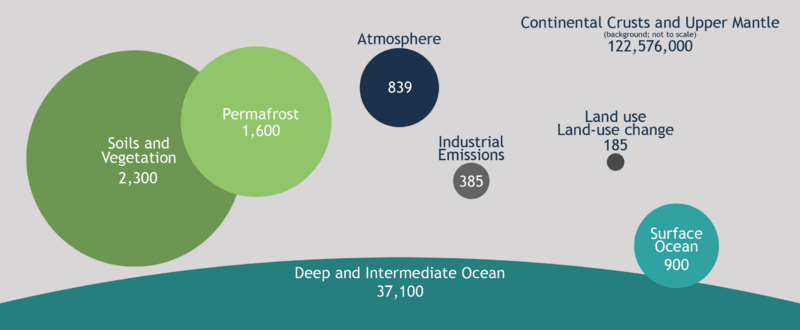Image: Global carbon stocks

Description: This image summarizes the relative sizes of the largest "stocks" or "pools" of carbon storage on the earth. The atmosphere is one carbon stock, and contains 839 gigatons of carbon (Gt C), mainly in the form of carbon dioxide (CO₂). The Earth’s largest carbon stock is found within the continental crusts and upper mantle of the Earth (122,576,000 Gt C), a large portion of which is sedimentary rock formed over millions of years (Mackenzie and Lerman 2006). Oceanic carbon is the next largest stock (37,100 Gt C). More than 95 percent of oceanic carbon is mainly present in the form of inorganic dissolved carbon, while only 900 Gt C is available for exchange in the surface ocean. Plants take up carbon through photosynthesis, and this carbon is subsequently allocated above- and below ground, contributing to the global vegetation stock. Globally, forests account for 92 percent of all terrestrial biomass, storing approximately 400 Gt C (Pan et al. 2013). Soils store approximately 1,325 Gt C in the top 1 meter of soil alone and 3,000 Gt C in total when soil at deeper depths is included, although large uncertainties are introduced due to unconstrained soil properties (such as peat bulk density and estimates of permafrost at depth, among others)(Köchy et al. 2015). In addition, permafrost (frozen soil) stores a large pool of carbon that is climatically protected from decomposition (Trumbore 2009; Schmidt et al. 2011), although more and more of this pool is becoming available as the average global temperature rises (Schuur et al. 2015, Guido et al. 2016). Carbon emissions to the atmosphere from human activity (predominantly the result of fossil fuel combustion and land-use change) have been rising since the industrial revolution. Fossil fuel combustion has contributed nearly 385 (+/- 20) Gt C since the industrial revolution up to year 2015, or about 70 percent of the total anthropogenic contribution since 1750 (570 +/- 70 Gt C) (Canadell and Schulze 2014). Land use and land-use change constitute the remaining 30 percent of emissions for the same time period, or 185 (+/- 65)Gt C. Image and Description Source Credit: M. Janowiak; W.J. Connelly; K. Dante-Wood; G.M. Domke; C. Giardina; Z. Kayler; K. Marcinkowski; T. Ontl; C. Rodriguez-Franco; C. Swanston; C.W. Woodall; M. Buford, Considering Forest and Grassland Carbon in Land Management, General Technical Report, Washington Office (WTO-GTR-95), United States Department of Agriculture, Forest Service, June 2017. https://www.fs.usda.gov/treesearch/pubs/54316 Additional References: Mackenzie, F.T.; Lerman, A. 2006. Carbon in the Geobiosphere:-Earth's Outer Shell. Springer Science & Business Media. Köchy, M.; Hiederer, R.; Freibauer, A. 2015. Global distribution of soil organic carbon–Part 1: Masses and frequency distributions of SOC stocks for the tropics, permafrost regions, wetlands, and the world. Soil. 1(1): 351-365. Trumbore, S. 2009. Radiocarbon and Soil Carbon Dynamics. Annual Review of Earth and Planetary Sciences. 37: 47-66. Schmidt, M.W.I.; Torn, M.S.; Abiven, S.; Dittmar, T.; Guggenberger, G.; Janssens, I.A.; Kleber, M.; Kogel-Knabner, I.; Lehmann, J.; Manning, D.A.C.; Nannipieri, P.; Rasse, D.P.; Weiner, S.; Trumbore, S.E. 2011. Persistence of soil organic matter as an ecosystem property. Nature. 478(7367): 49-56. Schuur, E.; McGuire, A.; Schädel, C.; Grosse, G.; Harden, J.; Hayes, D.; Hugelius, G.; Koven, C.; Kuhry, P.; Lawrence, D. 2015. Climate change and the permafrost carbon feedback. Nature. 520(7546): 171-179. Grosse, G.; Goetz, S.; McGuire, A.D.; Romanovsky, V.E.; Schuur, E.A. 2016. Changing permafrost in a warming world and feedbacks to the Earth system. Environmental Research Letters. 11(4): 040201. Canadell, J. G.; Schulze, E.D. 2014. Global potential of biospheric carbon management for climate mitigation. Nat. Commun. 5.
Title: Global carbon stocks
Credit: https://www.fs.usda.gov/ccrc/topics/global-carbon
Author: Zac Kayler, Maria Janowiak, Chris Swanston
Usage Terms: Public domain
License: Public domain
Attribution Required?: No
Image usage
The following page links to this image:

